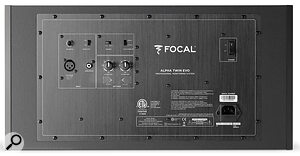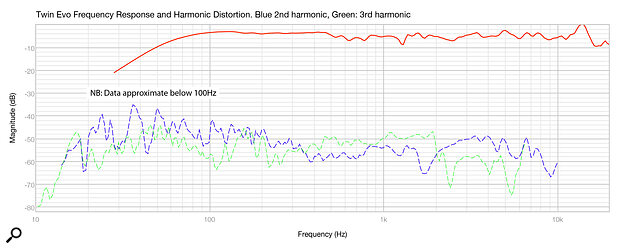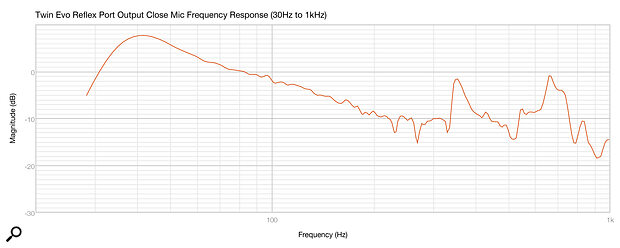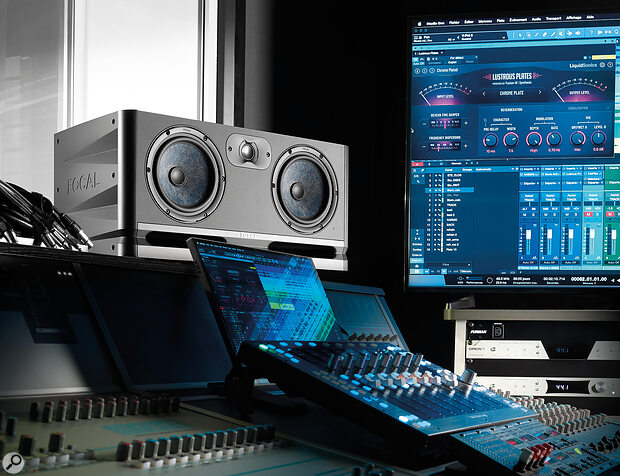Focal’s new MTM speaker offers remarkable bang for your buck!
When Hugh Robjohns reviewed the Focal Alpha 65 Evo in SOS September 2021, he was mighty impressed with its performance. The subject of this review is the 65 Evo’s grown‑up sibling, the Alpha Twin Evo — and when I say grown‑up, I’m not joking. The Twin Evo is pretty substantial for a nearfield monitor, and in the context of its still near entry‑level price, it appears to be a generous chunk of monitoring for the money.
Monitors of the Mid/Tweeter/Mid (MTM) driver format, like the Twin Evo, are sometimes able to be installed in either landscape or portrait orientation, but the Alpha Twin Evo is designed for landscape orientation only. So if the Twin Evo seems the monitor for you, make sure there’s enough space on your monitor shelf for a sensible installation. I’ll explain the reasons for this limitation a little further on.
The Twin Evo’s front panel carries twin 16.5cm bass/mid drivers, a 25mm tweeter, and healthily dimensioned slot‑style reflex ports beneath each bass/mid driver. Said bass/mid drivers are the same units as found in the Alpha 65 Evo and feature Focal’s proprietary ‘Slatefiber’ diaphragm material. Slatefiber is a composite material, exclusive to Focal, that comprises non‑woven carbon fibres in a thermoplastic polymer substrate. Focal claim that the carbon fibres add rigidity, whilst their being non‑woven introduces a damping effect. The resulting diaphragm, say, Focal is extremely stiff and light, but also well damped.
Focal have long been proponents of using stiff, light materials rather than soft fabrics for tweeter diaphragms, even to the point of employing beryllium for their higher‑end monitors. The Twin Evo tweeter dome is aluminium rather than beryllium, but that still falls into the stiff and light category. As has become a signature feature for Focal, the dome is inverted, having a concave rather than convex shape. Focal claim inherently better directivity and improved coupling between the diaphragm and its voice coil as positives for the inverted‑dome architecture. Ask manufacturers of conventionally arranged dome tweeters, however, and they’ll likely raise an eyebrow or two. My feeling is that there’s rather more to designing a good tweeter than whether it’s an ‘innie’ or an ‘outie’. Both can work equally well. Another interesting aspect of the Twin Evo tweeter is its waveguide. It features upper and lower intrusions on its very gently flared overall profile. The intrusions probably serve to modify the vertical dispersion of the tweeter somewhat.
Cabinet Meeting
The Twin Evo uses some attractively profiled plastic moulded components attached to the side panels and front panel of its MDF cabinet to prevent rectangular black box sameness becoming too strong. The front‑panel moulding also incorporates the reflex ports. I like the aesthetic style of the plastic mouldings, though the rebel in me would have dearly loved to see them finished in an alternative, contrasting colour. Even a grey would have helped relieve the unremitting blackness.
The Twin Evo ships with optional perforated metal grilles for each driver; the grilles clip into place in slots engineered into the driver chassis. I mostly used the monitors without grilles fitted but I suspect I’d be tempted to keep the exposed and delicate tweeter domes protected if I were the proud owner of a pair. As part of my FuzzMeasure analysis, I measured the frequency response with and without grilles fitted and found them to be reasonably innocuous. The only notable change with the grilles fitted was about 1dB gain on axis between 5.5kHz and 8kHz.
Back on the subject of the Twin Evo’s plastic side mouldings, one of the perennial manufacturing problems of attaching such items to a wooden construction is tolerancing. Plastic parts are typically manufactured much more accurately to their intended dimensions than wooden cabinets, which can often vary in their major dimensions by, say, ±0.5mm or even more. That’s apparent on the Twin Evo from the alignment of the plastic side panels to the cabinet — they don’t quite line up at the top, with one of the pair of review monitors having a worse mis‑match than the other. However, considering the entry‑level price of the Twin Evo, I’m perhaps being too fussy. Something else cabinet‑wise that I’m often fussy about is internal bracing and cabinet panel resonance, and I’m pleased to report that the Twin Evo is blessed with some significant internal bracing. It will serve to keep the cabinet panels much quieter than they otherwise would be — and they’re big cabinet panels so this is an important feature.
Symmetry
 The rear panel houses the analogue inputs, LF and HF EQ controls, and a switch for designating each monitor as either the Left or Right speaker.The rear panel of the Twin Evo carries the usual array of connection, amplification and configuration features. The Twin Evo has a fully analogue signal path, so its input connections comprise just balanced XLR and TRS sockets, along with an unbalanced RCA phono option. Amplifier power comprises 50 Watts for each bass/mid driver and 30 Watts for the tweeter. Configuration facilities include a switch to select alternative input sensitivities (0dB and +6dB), a switch to engage or disengage an auto‑standby feature, EQ knobs offering ±6dB LF adjustment and ±3dB HF adjustment and, unusually, a switch that assigns either left channel or right channel duties to each monitor of the pair. Why does it need a left/right switch? I will explain...
The rear panel houses the analogue inputs, LF and HF EQ controls, and a switch for designating each monitor as either the Left or Right speaker.The rear panel of the Twin Evo carries the usual array of connection, amplification and configuration features. The Twin Evo has a fully analogue signal path, so its input connections comprise just balanced XLR and TRS sockets, along with an unbalanced RCA phono option. Amplifier power comprises 50 Watts for each bass/mid driver and 30 Watts for the tweeter. Configuration facilities include a switch to select alternative input sensitivities (0dB and +6dB), a switch to engage or disengage an auto‑standby feature, EQ knobs offering ±6dB LF adjustment and ±3dB HF adjustment and, unusually, a switch that assigns either left channel or right channel duties to each monitor of the pair. Why does it need a left/right switch? I will explain...
The reason partly relates to Focal’s MTM design being intended for landscape orientation only. This constraint results jointly from the side‑panel mouldings and from the electroacoustic format of the Twin Evo, which leave it with asymmetric horizontal dispersion. Now, at a casual glance, you might expect the Twin Evo to be a D’Apollito design, where both bass/mid drivers work fully in parallel up to the crossover and then hand over to the tweeter, but it’s not. Focal have chosen to forego the symmetrical and narrower midrange horizontal dispersion of the D’Apollito configuration for the asymmetric but potentially wider (on one side) dispersion of what’s often known as a 2.5‑way system. In a 2.5‑way system, one bass/mid driver is slowly rolled off from, usually, a couple of hundred Hertz upwards, to leave just the second bass/mid driver to knit with the tweeter. The asymmetric horizontal dispersion that results from this arrangement means that the role of the two bass/midrange drivers (full‑range or rolled off) needs to be switched depending on a monitor’s left‑channel or right‑channel installation. Switched correctly, the inner bass/mid drivers of a pair of Twin Evos work full range up to the tweeter, whereas the outer drivers are effectively just bass drivers.
The potential advantages of an asymmetric system are that the inward horizontal dispersion is likely to be wider through the upper midrange than perhaps would be the case with a symmetrical D’Apollito arrangement. The disadvantages are firstly that there’s always a possibility of incorrectly configured switches (I tried it, it sounds weird); secondly that, in driving each bass/mid driver separately, the Twin Evo requires a third channel of power amplification; and lastly, that there’s actually an argument to be made that the narrower midrange dispersion of the symmetrical D’Apollito format is advantageous in nearfield monitoring. As ever, the proof will be in the listening.
Measuring Up
 Diagram 1. Twin Evo Frequency Response (right channel monitor). Red = on-axis. Green = 20-degree horizontal, switch right. Blue = 20-degree horizontal, switch left.
Diagram 1. Twin Evo Frequency Response (right channel monitor). Red = on-axis. Green = 20-degree horizontal, switch right. Blue = 20-degree horizontal, switch left.
Before I move on to the listening, some FuzzMeasure analysis. Diagram 1 illustrates the Twin Evo’s axial frequency response (red) along with curves illustrating its 20‑degree horizontal off‑axis response with the rear panel channel switch in the left (blue) and right (green) positions. The difference between the two off‑axis curves is apparent, and clearly one is more linear, and closer to the axial curve, than the other. The more linear of the two off‑axis curves corresponds to a listening position on the inside of the right channel speaker. Before I move away from Diagram 1, I’ll mention that the overall linearity of the Evo Twin axial response is pretty good. It displays a few mild lumps and bumps, but none to be particularly concerned about or that point to anything untoward going on.
 Diagram 2. Twin Evo Frequency Response (right channel monitor). Red = on-axis. Green = 40-degree horizontal, switch right. Blue = 40-degree horizontal, switch left.
Diagram 2. Twin Evo Frequency Response (right channel monitor). Red = on-axis. Green = 40-degree horizontal, switch right. Blue = 40-degree horizontal, switch left.
Diagram 2 illustrates similar data to Diagram 1 but this time the off‑axis angle is 40 degrees. The green curve denotes the channel switch in the right position and the blue curve denotes the switch in the left position. Again, the two curves reflect the Twin Evo’s asymmetric horizontal dispersion, but this time the less linear curve, the one with the sharp suck‑out, is actually the one that the channel switch would orient inwards towards the listening position. Now, assuming the Twin Evo monitor installation incorporated a degree or 10 of inward angle, 40 degrees off‑axis would put a listening position unrealistically close to the monitors, so this result is probably not hugely significant; however, considered together, Diagrams 1 and 2 do suggest that the Twin Evo, even with its 2.5‑way architecture and channel switch, demonstrates relatively narrow horizontal dispersion.
 Diagram 3. Twin Evo Frequency Response with Maximum and Minimum EQ settings.
Diagram 3. Twin Evo Frequency Response with Maximum and Minimum EQ settings.
Having broken out the measuring kit, I continued with a little further electro‑acoustic tyre‑kicking. Diagram 3 shows the result of setting the Twin Evo low‑ and high‑frequency EQ knobs to their maximum and minimum. The results match what is described in the Twin Evo specifications, though I do wonder about the practical use and advisability of the 6dB gain that the LF EQ offers. Firstly, I really can’t imagine an installation situation in which you’d need to apply that much bass boost: if you did, I’d suspect something was wrong or misunderstood about the room acoustics. And secondly, with only 50 Watts available to each bass/mid driver, there’s unlikely to be much headroom spare to accommodate 6dB of gain. Every 3dB of additional gain requires a doubling of amplifier power, so it’s not unlikely that maxing out the low‑frequency EQ will simply drive the amps into clipping. It will also likely drive the reflex ports into significant non‑linearity, too.
 Diagram 4. Twin Evo Frequency Response and Harmonic Distortion. Blue = 2nd harmonic. Green = 3rd harmonic.
Diagram 4. Twin Evo Frequency Response and Harmonic Distortion. Blue = 2nd harmonic. Green = 3rd harmonic.
I’ve recently found a new acoustic measuring environment that’s large enough to enable good accuracy down to lower frequencies (around 100Hz), which makes harmonic distortion measurements now a reasonable possibility. So Diagram 4 illustrates the Twin Evo axial response along with its second and third harmonic distortion. The monitor output level was around 85dB SPL at 1.5m distance. Above 100Hz, where the data is most accurate, the distortion hovers at between ‑45dB and ‑50dB, which corresponds to around 0.5% to 0.3% with no isolated peaks. This is a pretty good result.
Returning to the reflex ports, Diagram 5 illustrates a check on port tuning frequency and on any untoward output above the port’s intended low‑frequency contribution, using a measuring mic positioned right in the port mouth. The tuning frequency is at just over 30Hz, which seems reasonable considering the dimensions of the Twin Evo and its published low‑frequency bandwidth spec of ‑3dB at 38Hz. Port tuning down at 30Hz will ensure that the peak of the system group delay is located below most of the important musical elements, and will also help out the bass drivers by limiting their diaphragm displacement at the kind of frequency where things can otherwise get difficult.
 Diagram 5. Twin Evo Reflex Port Output Close Mic Frequency Response (30Hz to 1kHz).
Diagram 5. Twin Evo Reflex Port Output Close Mic Frequency Response (30Hz to 1kHz).
Diagram 5 does reveal some port output in addition to the desired resonance — the peaks at around 350Hz and 680Hz. These peaks suggest a combination of pipe resonance in the ports and energy bouncing around within the enclosure escaping to the outside world. Both will likely make a contribution to the subjective signature of the Twin Evo. Balancing the Q of the port resonance against attenuating the midrange energy inside the enclosure is one of the fundamental compromises of reflex loading. You can fill the enclosure with more wadding material to attenuate the energy, and that will help stop midrange leaking out through the port, but it will also significantly drop the Q of the port resonance. Some manufacturers use analysis and modelling techniques to predict the resonant behaviour inside the enclosure and then locate the internal mouth of the port at a standing wave node where energy is at a minimum. The problem with that is that the port’s length, one of its tuning variables, is then fixed and you’re left with only the cross‑sectional area to play with. But if you’ve chosen an industrial design aesthetic that requires two slot ports of a particular dimension, as on the Twin Evo, their area is pretty much fixed too, so you’re left with only length to adjust, and the port mouths end up internally wherever they end up.
Before I move on, a quick look inside one of the Twin Evo enclosures revealed only a very light filling with wadding, so it appears as if the Q of the port resonance has been prioritised by Focal over suppressing internal acoustic energy.
Listening In
I’ll move on now to how I felt the Twin Evo performed subjectively. As ever, I listened to a variety of familiar and favourite hi‑res streams and Pro Tools session sources. To kick off, my initial feeling that the Twin Evo constitutes a lot of monitoring for the money was confirmed by its undoubted ability to play at pretty much midfield monitor volumes without any apparent stress. Furthermore, it also subjectively offers very well extended, ‘big monitor’ style bass — its low‑frequency bandwidth genuinely sounds like it reaches the claimed 38Hz. In basic tonal balance terms through the vital midrange, the Twin Evo sounds spot on for monitoring, too, and in that respect it would undoubtedly be able to do a competent job in the studio. And I was particularly taken with the Twin Evo tweeter. It finds a genuinely satisfying balance between portraying detail and delicacy without drawing undue attention to itself. Almost always with less ambitious monitors I find myself using their rear‑panel EQ to turn the tweeter down a little. That wasn’t the case with the Twin Evo, and I remember being similarly impressed with the natural, unforced quality of the tweeter of the Focal Shape Twin when I reviewed it back in 2018 — so, disregarding any opinions on the benefits of ‘innie’ or ‘outie’ domes, tweeters seem to be something that Focal do well.
I was particularly taken with the Twin Evo tweeter. It finds a genuinely satisfying balance between portraying detail and delicacy without drawing undue attention to itself.
Of course no monitor is ever perfect, especially those at the Twin Evo’s competitive price, and to my ears it displays a couple of quirks. Firstly, the low‑frequency alignment that Focal have chosen is one that appears to prioritise bass bandwidth over precision, and that to my mind can make mix judgements of low‑frequency character and balance more tricky. To my ears, the Twin Evo’s bass is a little sluggish starting and stopping. Of course the up side of the Twin Evo’s impressive bass extension is that it renders audible low‑frequency elements in a mix that other smaller monitors might miss completely, but even so, I’d personally have preferred a bass compromise that’s more informative and less immediately attention‑grabbing. Attenuating the low frequencies a little using the onboard EQ of course helped balance things more to my liking, but I was still left struggling more than I’d hope to hear what was going on with, for example, basses and kick drums.
The other quirk is a mild coloration in the midrange that seems to flatten the stereo image a little and impart a slightly masked and boxy character, particularly to naturally recorded vocals. It’s a quirk that would probably be of little consequence with, for example, EDM or heavily processed guitars and vocals, where sounds do their heavy lifting though big‑picture tonality, but with more natural instruments and voices where communicative impact is based more on clarity and subtlety of expression, the Twin Evo for me was occasionally wanting.
The kind of coloration I think the Twin Evo displays is of course not remotely unusual in any monitor that’s built to a price, and the Twin Evo joins a roster of numerous monitors in and around the entry‑level price band that display their own particular signatures. High‑end (and, for many of us, unaffordable) monitors that get significantly closer to the ideal of imparting none of their own character on an audio signal are expensive for a reason — engineering compromise is simply avoided through far higher build cost. One of the skills inherent to designing and manufacturing monitors that hit a competitive cost target is knowing how to manage the compromises and to make the choices that result in a product that best meets the needs of the likely customers. I think the Focal Twin Evo expresses that skill very effectively, and in many cost‑effective mix scenarios, especially those that demand extended bass bandwidth and high volume levels, it will play the monitoring role to perfection. As ever, listen and see what you think.
Alternatives
With its twin bass/mid drivers the Twin Evo is a bit of an outlier at the price. However, if I were looking for something around a similar price point I’d probably also consider the Dynaudio Lyd 8, ADAM A7V, Kali Audio IN‑8 and Neumann KH120.
Pros
- Able to play loud without stress.
- Extended bass bandwidth.
- Great tweeter.
- Excellent value for money.
Cons
- Bass somewhat overblown.
- Slight midrange coloration.
Summary
The Twin Evo has its quirks, but its set of qualities is, I think, pretty much spot‑on for cost‑effective, high‑volume rock & roll monitoring. It’s an awful lot of monitoring for the money.
Information
£950 per pair including VAT.
SCV Distribution +44 (0)3301 222 500

